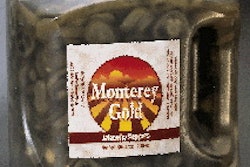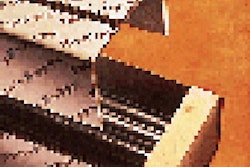Feeling vulnerable to the threat of plastic containers replacing waxed boxes for shipping produce and meats, two major players in the paper business have developed a recycling process that they claim separates the wax from paper fiber. Ideally, this means that waxed boxes would no longer need to be landfilled as they are now.
It's estimated that 3 million tons of fiber are used annually for the production of wax-coated boxes.
The recycling process accommodates boxes containing up to 35% wax by weight and cleans them through an unusual reverse-screening/high-temperature method (see sidebar, p. 28) that yields a furnish (or material supply) containing less than 1% wax. The furnish is meant to be used as a supplemental fiber for brown paper mills using old corrugated container stock.
Inland Paperboard and Packaging (Indianapolis, IN) and Thermo Black Clawson (Middletown, OH) hold a joint patent on the new Xtrax(TM) impurities extraction process. It was unveiled last December, after nearly 18 months of research and development. As of early July, no mill had yet implemented the Xtrax process commercially, though Packaging World is told that Inland and at least one other major supplier of paper used in packaging are close to doing so.
"The main goal of this process is to separate the paper fiber from the wax," says Jon Kerr, director of business development for Thermo Black Clawson. "A goal is to end up with a clean wax that can be sold back to wax manufacturers for recycling and selling back to boxmakers, and to recover clean fiber that can be reused in the paper production process."
Kerr says that previous separation processes have fallen short for several reasons. "Historically, there's been a problem in separating wax from fiber, and that's resulted in having wax spots in the board that show up as unwanted dark blemishes. We've demonstrated at our pilot plant here in Middletown that it can be done [without the dark spots]." Wax can also be problematic on boxmaking machinery and adversely affect the end quality of the finished board, particularly its printability.
For those reasons, brown paper mills using OCC usually cannot use more than 3% wax in their feedstock without reducing the quality of their end product. That drives the majority of waxed boxes to landfills, a costly process. This has prompted charges of non-recyclability from competitive container makers, according to the Xtrax patent holders.
Kerr explains that Thermo Black Clawson manufactures the equipment used for the Xtrax process. Inland's alternative fiber task force developed the Reverse Screening(TM) concept that cleans the wax from the paper fiber.
Downstream benefits
Xtrax will likely benefit food distributors who make use of wax's ability to accommodate products that need to be shipped wet, primarily produce, meat, fish and poultry.
Kerr explains that vegetable and meat packers are receiving constant requests from grocery stores with disposal problems. "Grocers tell us, 'Look, you've heard of the Green Dot program in Europe where suppliers take back their packaging materials.' They'd like us to do that here in North America. They want their meat and produce suppliers to take back their cartons."
Whether or not that ever happens, recyclable waxed boxes could go a long way in helping packers appease grocers. Grocers, it would appear, stand to benefit the most. Instead of disposing empty wax boxes in the trash and paying haulers to landfill them along with other store refuse, the Xtrax process creates the potential for stores to sell waxed boxes to recyclers. Employees would be instructed to knock down and save waxed cases, rather than discard them.
Store employees could find it easier to separate plain corrugated from waxed boxes thanks to a voluntary program spearheaded by the Fiber Box Assn. (see PW, April '98, p. 101). The program aims to reduce by 10% to 15% the amount of non-waxed boxes currently being landfilled, so that those boxes could be recycled. That could help stores cut disposal costs.
The program involves boxmakers using (presumably) existing coding and marking equipment to mark two inner, top flaps with the word "wax" in English/French/Spanish. Additionally, a colorful poster showing a filled broccoli box with these marks would be sent to grocery stores to display in appropriate backroom areas. FBA is working in conjunction with the Food Marketing Institute on this poster, which also says, "When you see wax/cera/cire on the flaps of a box, Separate It! Separate waxed boxes from regular boxes."
Pressure from plastics
While these potential financial benefits for downstream customers should help Inland and Thermo Black Clawson market Xtrax, the process may help the two companies head off a possible erosion of market share to plastic containers.
"The threat of reusable plastic crates replacing non-recyclable waxed containerboard should concern every linerboard and medium producer, as well as each and every corrugated sheet plant converter," said William B. Howes, Inland's chairman and CEO in a March 9 press release issued by Inland to introduce Xtrax.
The release noted that wax-coated boxes had come under attack from the plastics industry, which the Inland release said was, "reminiscent of the grocery store battle over the bags used at the checkout counter. Claims of non-recyclability adversely affected the popularity of the waxed corrugated paper box."
Thermo Black Clawson's Kerr believes "the paper industry lost that battle in the grocery stores as plastic has replaced the paper sack. The real issue now is paper versus plastic [as] plastic corrugated cartons compete with the waxed corrugated box for produce, fish and meats."
Naturally, Inland and Black Clawson want the lion's share of that market. In the U.S., Kerr estimates that more than three million tons of paper fiber is used annually for the manufacture of wax-coated boxes. He says that an excess capacity of board already exists. "If plastic takes over and paper loses that production, we'd have a far greater amount of capacity that wouldn't be absorbed."
Marketing its advantages
The headline of Inland's March press release, "Wax-coated boxes saved from extinction--now recyclable with patented process," reflects the company's concern for the future of wax-coated boxes.
Selling paper mills, grocers and meat and produce packers on the idea that waxed cases can be recycled and reused appears to be the first goal for the Xtrax patent holders.
"The packer has to pay for the plastic or wax container, and when it comes to the economics of the decision, the packer is caught between a rock and a hard place," Kerr believes. "The packer pays more for the plastic container but has no disposal problem." Traditionally, he says, "with waxed corrugated, the cost was less, but [the case] couldn't be reused." With the Xtrax process, Inland and Thermo Black Clawson are banking on waxed boxes gaining a leg up on the competition.
But Kerr acknowledges that there are at least two significant hurdles. One, he says, has to do with current excess fiber capacity. "We're trying to sell this process to paper companies. [But] prices are down, margins are thin, and the industry is undergoing a series of consolidations," he notes. "Large corporations are spending what funds they have on debt restructuring and mergers and acquisitions, so they're not really approving much capital in terms of expanding fiber production."
That leads to the second hurdle: cost. Kerr estimates that constructing a building and purchasing the equipment necessary for the Xtrax system is "in the $9 to $12 million range, and that's assuming you already have power, water, steam and waste disposal [services]."
Those are two key reasons why the system had yet to be installed as PW went to press. However, Inland and Thermo Black Clawson believe their patented Xtrax system holds considerable promise for the waxed box business. "We would like to have an order booked by the end of this month," concludes Kerr.

























